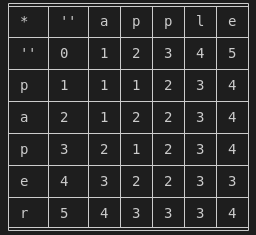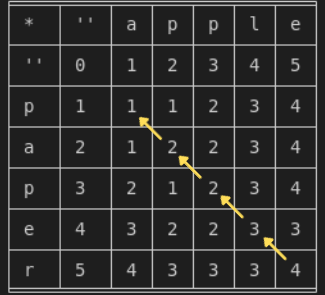我在 Youtube 上观看了一段视频,解释了如何通过从动态规划算法获得的矩阵的最后一个单元格回传 1 来计算使用了哪些操作以及使用了多少次。虽然我理解视频中的示例,但当我尝试使用其他示例时,我无法做到。是否可以在矩阵上显示每个解决方案?我还在最后添加了计算矩阵的代码。
假设我们的词是"apple"和"paper"。
从动态规划算法获得的矩阵(我使用了 Levensthein 距离运算。):

“apple”和“paper”的最小编辑距离为 4。
解决方案之一是 4 次替换操作。
1. a pple -> p pple(将“a”替换为“p”)
2. p p ple -> p a ple(将“p”替换为“a”)
3. pap l e -> pap e e(将“l”替换为“e”)
4. pape e -> pape r(将“e”替换为“r”)
矩阵解法:

是否可以在此矩阵上显示其他解决方案?
例如:
1. apple -> papple(插入“p”)
2. papple -> paple(去掉“p”)
3. paple -> pape(去掉“l”)
4.纸 -> 纸(插入“r”)
代码:
def min_edit_count(word1, word2):
word1 = ' ' word1 #
word2 = ' ' word2 # add a space before original words
len_w1 = len(word1) #
len_w2 = len(word2) # calculate the lengths of new words
edit_matrix = np.zeros((len_w2, len_w1), dtype = int)
# create a matrix with all zeros
edit_matrix[0, :] = range(len_w1)
# assign numbers from 0 to len_w1 in the first row of the edit_matrix
edit_matrix[:, 0] = range(len_w2)
# assign numbers from 0 to len_w2 in the first column of the edit_matrix
for i in range(1, len_w2):
for j in range(1, len_w1):
# edit_matrix[i-1][j] --> remove
# edit_matrix[i][j-1] --> insert
# edit_matrix[i-1][j-1] --> replace
temp1 = edit_matrix[i-1][j] 1
temp2 = edit_matrix[i][j-1] 1
# add 1 to edit_matrix[i-1][j] and edit_matrix[i][j-1]
temp3 = edit_matrix[i-1][j-1] 1 if word1[j] != word2[i] else edit_matrix[i-1][j-1]
# if last characters are same don't add 1 to edit_matrix[i-1][j-1].
# no need to replace
edit_count = min(temp1, temp2, temp3)
# find min between three numbers
edit_matrix[i][j] = edit_count
min_edit = int(edit_matrix[len_w2 - 1, len_w1 - 1])
# minimum edit count is the last number calculated
return min_edit, edit_matrix
uj5u.com热心网友回复:
是的,您可以从最后回溯可能有助于解决方案的单元格。
复杂性是O((n m) * num_solutions).
def getSolutions(edit_matrix, word1, word2):
pos = []
def backtrack(i,j):
pos.append((i,j))
if i==0 and j==0:
# This is a solution
print(pos)
if i>0 and edit_matrix[i-1,j] 1 == edit_matrix[i,j]:
backtrack(i-1,j)
if j>0 and edit_matrix[i,j-1] 1 == edit_matrix[i,j]:
backtrack(i, j-1)
if i>0 and j>0 and (edit_matrix[i-1][j-1] 1 if word1[j] != word2[i] else edit_matrix[i-1][j-1]) == edit_matrix[i,j]:
backtrack(i,j)
pos.pop()
backtrack(len(word1) - 1,len(word2) - 1)
uj5u.com热心网友回复:
基于 Sorin 的好回答,这里有一个稍微增强的版本,它已修复以适合您的索引,并列印在每种情况下需要完成的编辑操作:
def get_solutions(edit_matrix, word1, word2):
pos = []
sol = []
def backtrack(i,j):
pos.insert(0, (i,j))
if i==0 and j==0:
# This is a solution
print(str(pos) ": " str(sol))
if i>0 and edit_matrix[i-1,j] 1 == edit_matrix[i,j]:
sol.insert(0, "insert " word2[i])
backtrack(i-1,j)
sol.pop(0)
if j>0 and edit_matrix[i,j-1] 1 == edit_matrix[i,j]:
sol.insert(0, "remove " word1[j])
backtrack(i, j-1)
sol.pop(0);
if i>0 and j>0 and edit_matrix[i-1][j-1] 1 if word1[j] != word2[i] else edit_matrix[i-1][j-1] == edit_matrix[i,j]:
if (word1[j] != word2[i]):
sol.insert(0, "replace " word1[j] " with " word2[i])
else:
sol.insert(0, "skip")
backtrack(i-1,j-1)
sol.pop(0)
pos.pop(0)
word1 = ' ' word1
word2 = ' ' word2
backtrack(len(word2) - 1,len(word1) - 1)
示例输出
count, matrix = min_edit_count("apple", "paper")
get_solutions(matrix, "apple", "paper")
然后看起来如下:
[(0, 0), (1, 0), (2, 1), (3, 2), (3, 3), (3, 4), (4, 5), (5, 5)]: ['insert p', 'skip', 'skip', 'remove p', 'remove l', 'skip', 'insert r']
[(0, 0), (0, 1), (1, 2), (2, 2), (3, 3), (3, 4), (4, 5), (5, 5)]: ['remove a', 'skip', 'insert a', 'skip', 'remove l', 'skip', 'insert r']
[(0, 0), (1, 0), (2, 1), (2, 2), (3, 3), (3, 4), (4, 5), (5, 5)]: ['insert p', 'skip', 'remove p', 'skip', 'remove l', 'skip', 'insert r']
[(0, 0), (1, 1), (2, 2), (3, 3), (3, 4), (4, 5), (5, 5)]: ['replace a with p', 'replace p with a', 'skip', 'remove l', 'skip', 'insert r']
[(0, 0), (0, 1), (1, 2), (2, 3), (3, 4), (4, 5), (5, 5)]: ['remove a', 'skip', 'replace p with a', 'replace l with p', 'skip', 'insert r']
[(0, 0), (1, 0), (2, 1), (3, 2), (4, 3), (5, 4), (5, 5)]: ['insert p', 'skip', 'skip', 'replace p with e', 'replace l with r', 'remove e']
[(0, 0), (1, 0), (2, 1), (3, 2), (4, 3), (4, 4), (5, 5)]: ['insert p', 'skip', 'skip', 'replace p with e', 'remove l', 'replace e with r']
[(0, 0), (1, 0), (2, 1), (3, 2), (3, 3), (4, 4), (5, 5)]: ['insert p', 'skip', 'skip', 'remove p', 'replace l with e', 'replace e with r']
[(0, 0), (0, 1), (1, 2), (2, 2), (3, 3), (4, 4), (5, 5)]: ['remove a', 'skip', 'insert a', 'skip', 'replace l with e', 'replace e with r']
[(0, 0), (1, 0), (2, 1), (2, 2), (3, 3), (4, 4), (5, 5)]: ['insert p', 'skip', 'remove p', 'skip', 'replace l with e', 'replace e with r']
[(0, 0), (1, 1), (2, 2), (3, 3), (4, 4), (5, 5)]: ['replace a with p', 'replace p with a', 'skip', 'replace l with e', 'replace e with r']
//fun: 你可以试着看看为什么每一行都有相同的长度 :D








0 评论